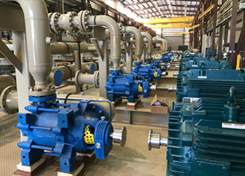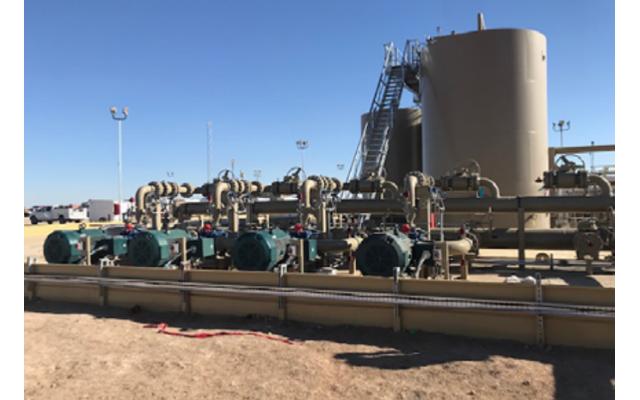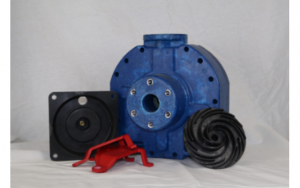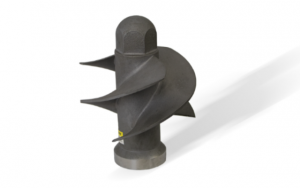Contributor: Carver Pump
With approximately one million active oil and gas wells1, the United States is estimated to generate between 21 to 25 billion barrels2 of produced water each year2 (fun fact: this is more than double the amount of water that typically flows over Niagara Falls each day1). So what is produced water and why do we care how it is pumped?
Produced water is extracted along with crude oil and natural gas as it is brought up to the surface. Typically mixed with oil, grease, hydrocarbons and other compounds, produced water is often very salty and can sometimes have a higher salinity content than seawater1! This salinity is a very important consideration when evaluating a pump’s materials of construction especially if brackish.

These ring section pumps in the Permian Basin are used for produced water disposal, which requires pumps that can reliably deliver high pressure in challenging environments. For this project, Carver Pump provided duplex stainless steel pumps to stand up to the brackish water.
Brackish water can be very hard on the internal components of a pump, shortening the overall life span of the equipment. Choosing a pump with the appropriate metallurgy can make a huge difference in reliability and longevity. Proper materials of construction also matter when it comes to handling solids and abrasives that may be mixed in with the produced water. In many cases, there are filters and/or strainers that are installed in the suction piping ahead of where produced water pumps operate in the system.
Oil and gas producers are required by law to treat the produced water. This may include sending it out for third-party disposal, evaporating it from onsite holding ponds, discharging it back into offshore water bodies, or reinjecting it underground. Before produced water can be injected into Class II injection wells3, pumps transport the produced water through various separation and treatment processes4. The second consideration when selecting a pump for produced water transport is to understand the process and determine if high pressure pumps are needed.
Oil and gas producers often require pumps that can accommodate pressure ranges from 1400 PSI to upwards of 4000 PSI. These high pressures are not out of the ordinary when you realize what it takes to reinject produced water into buried wells, deep caverns, long pipelines, and even for use in the hydraulic fracking process. High pressure ring section pumps can be installed in series arrangement to meet high pressure requirements. The photo at the top of this article shows a pump system designed with Carver Pump where each of the 12 RS D-sized pumps delivered up to 700 gallons per minute, each operating in parallel for high volumes. These pumps were built with a ‘blind stage’ so that discharge pressure could be upgraded in the future without any change to the system piping. The modular nature of the design allows the Engineers at Carver Pump to precisely meet the oil and gas operator’s conditions of service.
Check out the RS Pump from Carver Pump
Produced water usually never gets hot enough that temperature is ever an issue, but when it comes to high pressure pumping applications, Safety is always a concern. Make sure that the pump meets or exceeds maximum allowable working pressure.
If you have any questions about pumping produced water, contact Carver Pump today!
References
1 http://www.producedwatersociety.com/produced-water-101/
2 https://www.epa.gov/sites/production/files/documents/stewart_1.pdf
3 https://www.epa.gov/uic/class-ii-oil-and-gas-related-injection-wells
5 https://www.carverpump.com/wp-content/uploads/2018/07/RS-Upstream-Brochure-Screen.pdf
6 https://ehsdailyadvisor.blr.com/2018/11/use-of-produced-water-faces-federal-and-state-regulations/
About Carver Pump
Since we built our first pumps in 1938, Carver Pump has become recognized as one of the leading centrifugal pump companies, building pumps to the most demanding engineering specifications and military standards in the world. We were one of the first American pump companies to attain ISO 9001 certification – the most recognized standard for quality in the world. This certification is your assurance that our commitment to quality includes not only our hardware, but also superior customer service, leading-edge R&D, and continuous improvement in everything we do. So whether the job is refueling fighter jets on the deck of an aircraft carrier, supplying paint to an auto assembly line, or bringing water to the fountain in a city park, we put our reputation on the line everyday with every pump we build. Learn more at www.carverpump.com.





Comments